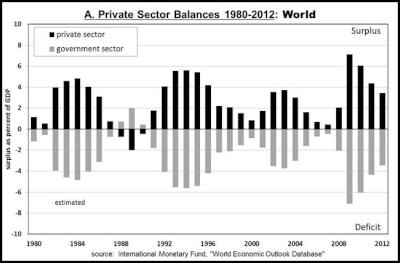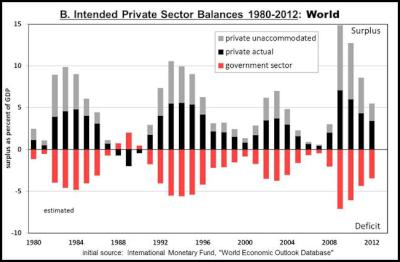Global Savings Glut
by Keith Rankin
21 February
2014
Last week I presented two papers at the 2014 Asia-Pacific Economic History conference in Hamilton.
One paper, about global financial imbalances, started by considering the world economy (in the 2000s' decade) as a whole and then looking (back as far as the 1980s) at national financial signatures for, in particular, the Australasian countries and the Nordic countries. It turns out that, of the countries included in this study, the most interesting (and worrying) country was Sweden. Sweden itself remains prosperous, much less unequal than most, and weathered the post-2008 financial crisis rather well. The problem is that, if all countries try to emulate Sweden's post-1990 financial strategies, then the world's economy and financial system will crash horribly.
For the world as a whole, we can divide the economy into two sectors: government and private. The global government sector is all the world's governments combined. The private sector is all other organisations, businesses and households. Actual financial balances – unlike intended balances – are a zero-sum game. The sum of all financial balances is zero. So if one sector runs a deficit of say one trillion dollars, then the remaining sector(s) must run a surplus of one trillion dollars. (This can be summarised as: "Your surplus is my deficit.")
Essentially, finance – and hence goods and services – flows from the surplus sector(s) to debt-fund the deficit sector(s).
Classical and neoclassical economists tend to assume that spending and borrowing in the government sector is autonomous (ie fully determined in their fiscal policies as outlined in their budgets) and that the private sector accommodates to this position. Hence they assume that governments "crowd-out" private businesses, and they assume that periodic unemployment is caused by a mixture of workers insisting on above-market wages and by institutions that inhibit labour market flexibility.
These assumptions are untenable in the light of the evidence, especially evidence from the past 10 years, and evidence from Japan for over 20 years. It is clear that private spending and borrowing behaviour is largely autonomous, and becomes much more cautious after a major financial event. It is also becoming clear that businesses (in the aggregate) are increasingly savers and hoarders rather than the borrowers and investors that neoclassical economics requires. (Apple Corporation is reputed to be the worst offender.)
In my paper I used IMF (International Monetary Fund) data to show global private and government balances from 2001 to 2010, the only years for which that data is available.
This week I have extended this by using major-country data to estimate global deficit and surplus balances from 1980 to 2012. We note that only in the late 1980s was the world's private sector in deficit. Except in unusual times, the private sector is creditor to the government sector, and private surpluses add each year to the accumulated credit-debt imbalances between private parties and governments. The short-run health of the world's capitalist economy depends utterly on governments accepting rather than resisting their debtor role. (The long run health requires changes in private, not government, behaviour.)
The first chart shows global surpluses and deficits since the 1980s. Note that surpluses represent a mix of new savings and debt repayment. After financial crises, the most important dynamic is that of debt repayment. Signs are that, in 2014, the private sector is much more willing to take on new debt than in say 2010, especially in the English-speaking world. (Note that the figures are expressed as a percentage of world GDP, rather than in trillions of dollars.)

Click for big version.
The second chart shows an estimate of private sector intent. The additional feature is unaccommodated private balances, and results from government resistance to taking up the slack when private spending is insufficient to achieve anything like full employment.

Click for big version.
As a result of insufficient total spending, workers save less than they intend or they borrow more than they intend. This is because their incomes become less than they expected, as their employers' balance sheets come under pressure. Also, when aggregate spending is weak, businesses seek to hoard profits rather than spend them on new plant and equipment. Essentially, the unaccommodated (ie thwarted) private balances indicate unemployment.
Recessions occur when intended surplus balances increase, or when intended deficit balances decrease. When recessions occur, actual surplus balances fall short of intended balances, and deficit balances exceed intended deficits. We may note that if governments are willing to run very large deficits after a financial crisis, then intended surplus balances are not thwarted, and the recession does not occur.
If we now turn to individual countries, then we have sets of three-sector charts. The third sector is the foreign sector. Different countries have their own signature charts, and, since the early 1990s, Sweden's chart has been substantially different to New Zealand's.

Click for big version.
New Zealand's chart over the whole period is dominated by its current account deficit. This translates as a foreign-sector surplus. Thus, for decades, the rest of the world has made resources available to New Zealanders to use, albeit as a set of annual increments to New Zealand's external debt.
We see that, up to the early 1990s, the New Zealand government was the main recipient of these foreign surpluses. After that, it was the New Zealand private sector. Thus we see that New Zealand has a financial profile vastly different to that of the world as a whole. More than any other country, New Zealand consistently runs private sector deficits of over five percent of GDP. This spending generated lots of tax.
From 2009 to 2011, the government took up the slack to some extent, as private New Zealanders addressed their debt issues. We can sense that, from 2014, New Zealand is most likely to revert to form. What this means is that, in its own small way, New Zealanders accommodate the private surpluses ('savings glut') of the rest of the world.
Sweden has a quite different financial profile. After, in the late 1980s, running up private sector debt that led to housing and sharemarket bubbles, Sweden suffered a major financial and banking crisis. Its banks were bailed out through semi-nationalisation, much as Air New Zealand was rescued in 2001.

Click for big version.
From 1992, Sweden's private sector has experienced an extended austerity phase. Initially the Swedish government accommodated this massive switch from a short-lived casino economy in the 1980s to a very Germanic savings profile. But by 1995, we can see the government pulling back, implementing its own austerity programme. It is the foreign sector that has accommodated Sweden's austerity, and has done so for nearly 20 years. Austerity – dare I say it, miserliness – has become a national habit in Sweden. New Zealanders, and others, must (and indeed do) spend on Swedes' behalf what Swedes' incomes entitle Swedes to spend, but which they do not spend, and show no sign of spending. If Swedes do not sometime go on an import binge then we will look back and, with hindsight, interpret their surpluses as gifts to the likes of New Zealanders. (In the same vein, China has effectively gifted the USA the means to fight its wars.)
It was much the same in the Eurozone. So long as Greeks and Spaniards were spending Germany's chronic surpluses, then the Euro economy seemed to grow and prosper.
If every country behaved like Sweden does, then the intended private sector surpluses would not materialise. Rather the world economy would go into a downwards spiral. Indeed all the major world's economies tried to do in the 1920s precisely what Sweden has succeeded in doing since the mid 1990s. Sweden has surpluses all round – private surpluses, government surpluses and current account surpluses. But the surplus game is a zero-sum game. The total of the world's surpluses is precisely zero.
We cannot all be like Sweden. The world economy prospers only if some countries – private parties or governments – buy the surplus goods and services that the Swedes produce but do not buy. Since the financial crises in various parts of the world in the last 25 years, increasing numbers of countries effectively give their goods and services away, in order to maintain private sector balance sheets much like Sweden's.
The biggest of course is China. As an emerging economy, this financial strategy makes some sense in China. The Swedes and the Swiss and the Dutch and the Singaporeans have, however, earned the right to produce less and relax more.
Keith Rankin teaches economics at Unitec's Department of Accounting and Finance. http://new.rankinfile.co.nz



 Martin LeFevre - Meditations: History Is Not A Game
Martin LeFevre - Meditations: History Is Not A Game Peter Dunne: Dunne's Weekly - ACT Looks Backwards
Peter Dunne: Dunne's Weekly - ACT Looks Backwards Binoy Kampmark: Funeral Atmospherics At The British Library
Binoy Kampmark: Funeral Atmospherics At The British Library Ramzy Baroud: Dear World - This Is What Palestinian Unity Looks Like
Ramzy Baroud: Dear World - This Is What Palestinian Unity Looks Like Ian Powell: Reti’s Velvet Glove Wore Too Thin For PM’s Iron Fist
Ian Powell: Reti’s Velvet Glove Wore Too Thin For PM’s Iron Fist Ian Powell: Reckless Disregard Or Cruelty (Or Even Trumpian!)
Ian Powell: Reckless Disregard Or Cruelty (Or Even Trumpian!)